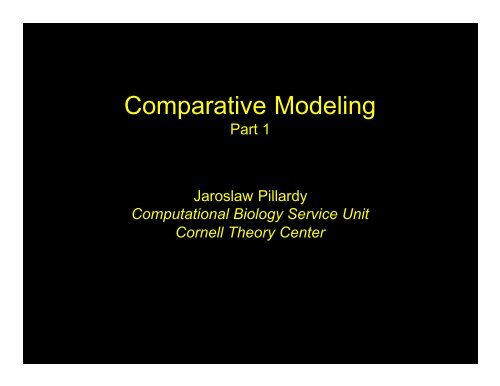MODELLER - Computational Biology Service Unit (CBSU)
MODELLER - Computational Biology Service Unit (CBSU)
MODELLER - Computational Biology Service Unit (CBSU)
Create successful ePaper yourself
Turn your PDF publications into a flip-book with our unique Google optimized e-Paper software.
Comparative Modeling<br />
Part 1<br />
Jaroslaw Pillardy<br />
<strong>Computational</strong> <strong>Biology</strong> <strong>Service</strong> <strong>Unit</strong><br />
Cornell Theory Center
• Function is the most important feature of a<br />
protein<br />
• Function is related to structure<br />
• Structure is related to sequence
Exchange of even a few residues can (and often does)<br />
change a structure and destabilizes a protein.<br />
Multiple random mutations that preserve structure are<br />
statistically unlikely.<br />
Mutations resulting in a structural change are not likely to<br />
survive since function is lost …<br />
There is a very significant evolutionary pressure for structure<br />
conservation.
RESULT:<br />
STRUCTURE IS MORE CONSERVED THAN SEQUENCE<br />
All naturally evolved proteins of sequence identity of 35% or<br />
more have similar structures.<br />
Majority of proteins with sequence similarity of 15% or more<br />
still have similar structures, however degree of similarity<br />
decreases with sequence similarity.<br />
Using sequence-to-sequence alignment a model can be<br />
constructed when structure of one of aligned proteins is<br />
known …
Comparative Modeling is an algorithm for<br />
constructing a 3-dimensional model of a protein<br />
based on a known structure of another protein<br />
(template) when optimal alignment of the two<br />
sequences is known.<br />
•When sequences are similar BLAST alignment (usually<br />
modified) may be used, often leading to a model with quality<br />
corresponding to low-resolution experimental (X-ray or<br />
NMR) structure. This is the only method for protein structure<br />
prediction capable of producing models that close to<br />
experiment.<br />
•For distantly related sequences alignment obtained with<br />
different methods may be used.<br />
•Quality of an alignment may be assessed by analyzing a<br />
model.
Why is 3D model important?<br />
Typical problem: prediction of protein function.<br />
It may be done in some cases by sequence matching to a<br />
protein of a known function and/or recognizing block of<br />
sequence of known function.<br />
The 3D structure of a protein generally provides much<br />
more information about its function than sequence because<br />
interactions of a protein with other molecules are<br />
determined by amino acids that are close in space but<br />
frequently distant in sequence (e.g. serine proteases) …
1EA5 Acetylcholinesterase<br />
Typical triad<br />
contains ASP<br />
SER 200<br />
HIS 440<br />
GLU 327<br />
DDHSELLVNTKSGKVMGTRVPVLSSHISAFLGIPFAEPPVGNMRFRRPEPKKPWSGVWNASTYPNNCQQYVD<br />
EQFPGFSGSEMWNPNREMSEDCLYLNIWSSEEEBSVPSPRPKSTTVMVWIYGGGFYSGSSTLDVYNGKYLAY<br />
TEEVVLVSLSYRVGAFGFLALHGSQEAPGNVGLLDQRMALQWVHDNIQFFGGDPKTVTIFGESAGGASVGMHI<br />
LSPGSRDLFRRAILQSGSPNCPWASVSVAEGRRRAVELGRNLNCNLNSDEELIHCLREKKPQELIDVEWNVLPF<br />
DSIFRFSFVPVIDGEFFPTSLESMLNSGNFKKTQILLGVNKDEGSFFLLYGAPGFSKDSESKISREDFMSGVKLSV<br />
PHANDLGLDAVTLQYTDWMDDNNGIKNRDGLDDIVGDHNVICPLMHFVNKYTKFGNGTYLYFFNHRASNLVWP<br />
EWMGVIHGYEIEFVFGLPLVKELNYTAEEEALSRRIMHYWATFAKTGNPNEPHSQESKWPLFTTKEQGGTGGG<br />
KFIDLNTEPMKVHQRLRVQMCVFWNQFLPKLLNATAC
Why not to use 3D structure of template?<br />
Model is similar, but not identical to the template.<br />
•Side chains are replaced and backbone conformation<br />
modified if necessary. They must be packed optimally in<br />
the protein core.<br />
•Gaps on the target side of alignment are filled by<br />
constructing and optimizing loops.<br />
•Gaps on the query side of alignment are removed by<br />
moving segments of protein in space and relaxing parts of<br />
its structure.
In general model should be a little closer to the target<br />
structure than the template.<br />
This is especially true when more than one template is<br />
being used – this is because model tends to inherit the best<br />
structural features from different templates.<br />
It is always better to use comparative model to represent<br />
target rather than its template. This is because errors in<br />
alignment (typical source of bad models) affect similarly the<br />
use of the template as a representation of the target as well<br />
as the comparative model based on the same template.
Various applications for comparative models:<br />
•Designing (site-directed) mutants to test hypotheses about function<br />
•Identifying active and binding sites<br />
•Searching for ligands of a given binding site<br />
•Modeling substrate specificity<br />
•Predicting antigenic epitopes<br />
•Protein-protein docking simulations<br />
•Inferring function from calculated electrostatic potential<br />
•Molecular replacement in X-ray structure refinement<br />
•Testing a given sequence-structure refinement<br />
•Rationalizing known experimental observations<br />
•Planning new experiments
Modeling a putative interaction of<br />
a predicted YDL117W SH3<br />
domain with a proline-rich<br />
peptide.<br />
A segment in the yeast ORF<br />
YDL117W sequence (Top) was<br />
predicted to be remotely related<br />
to the SH3 domains, many of<br />
which have known 3D structure.<br />
[R. Sànchez and A. Šali, PNAS<br />
Vol. 95, Issue 23, 13597-13602<br />
(1998)]
Comparative Modeling is broadly applicable.<br />
It has been estimated that approximately one third of all<br />
sequences are related to at least one protein of known<br />
structure. Since there are approx 1,000,000 known protein<br />
sequences comparative modeling could be applied to<br />
approximately 300,000 proteins. It is 17 times more than<br />
the number of known protein structures in the PDB<br />
(18,000).<br />
The number of possible distinct protein folds may be<br />
limited. In this case at some point in the future at least one<br />
example of most structural folds will be known making<br />
comparative modeling applicable to most protein<br />
sequences.
<strong>MODELLER</strong> is a very popular comparative modeling program.<br />
It is a part of many commercial packages<br />
(e.g. InsightII from Accelrys).<br />
It is also available for free from the authors at<br />
http://guitar.rockefeller.edu/modeller/modeller.html
How does the <strong>MODELLER</strong> work?
How does the <strong>MODELLER</strong> work?<br />
Optimization of the objective function (curve) starts with a distorted average of<br />
template structures (not with an extended structure as shown here). The iteration<br />
number is indicated below each sample structure. In this run, the first iterations<br />
correspond to the variable target function method relying on the conjugate gradients<br />
technique. This approach first satisfies sequentially local restraints and slowly<br />
introduces longer range restraints until the complete objective function is optimized.
<strong>MODELLER</strong>’s approach (spatial constraints) is very similar to<br />
refining of a NMR structure. Other approaches are:<br />
• Rigid body assembly. This group of methods constructs<br />
the model from a few core regions and from loops and<br />
side chains, which are obtained from dissecting related<br />
structures. The assembly involves fitting the rigid bodies<br />
on the framework defined as the average of the C α atoms<br />
in the conserved regions of the fold.<br />
• Segment matching. Database of short protein fragments<br />
is used to calculate the coordinates of atoms based on<br />
positions of conserved atoms.
Model accuracy depends on sequence identity.
<strong>MODELLER</strong> flowchart<br />
sequence<br />
Identify related structures (templates)<br />
Select templates<br />
Calculate alignment<br />
Build model<br />
Evaluate model<br />
structure
Template selection<br />
• High sequence similarity<br />
• Select a template from a subfamily phylogenetically<br />
closest to query sequence<br />
• Environment of target structure should be as similar as<br />
possible to the query. It may be solvent, ligand, pH,<br />
quarternary interactions.<br />
• The quality of template structure should be as high as<br />
possible as described by resolution for X-ray, and number<br />
of constraints (NOE) for NMR.
Alignment.<br />
• When sequence similarity is above 40% alignment is<br />
simple to obtain.<br />
• If sequence similarity is lower the alignment usually<br />
contains gaps and requires manual intervention in order to<br />
minimize the number of misaligned residues. Structural<br />
information from template usually helps: gaps should be<br />
avoided inside secondary structure elements, in buried<br />
regions and between residues far apart in space.
Model evaluation.<br />
• Evaluating model is also assessing quality of the template<br />
as well as the correctness of an alignment. However in<br />
practice it is hard to tell which part is wrong …<br />
• Energy profile may be used, but available force fields are<br />
by far not perfect themselves.<br />
• Visual inspection of amino acid packing versus various<br />
physical/chemical properties (hydrophobicity, charge<br />
distribution etc) is usually the most important tool.<br />
• Stereochemical properties (bond lengths, bond angles,<br />
atom-atom overlaps). They can be checked automatically<br />
(ProCheck).
Problems and limitations.<br />
As the similarity between query and template sequences<br />
decrease, the errors in model increase.<br />
• Sidechain packing. Sometimes even the conformation of<br />
identical sidechains is not conserved. This is not very<br />
important unless these sidechains are close to the active site.<br />
• Distortions and shifts in correctly aligned regions. As a<br />
consequence of sequence divergence the backbone<br />
conformation also changes even if the overall fold<br />
remains the same. This error can be also due to<br />
different environment.
Problems and limitations.<br />
• Errors in regions without template (loops). Usually<br />
insertions of length 8 or less residues are possible to<br />
model (but with lower accuracy). Longer insertions are<br />
usually not modeled correctly and should be avoided.<br />
• Misalignments. The largest source of errors, especially<br />
below 40% sequence identity. It can be avoided by<br />
using multiple sequence alignments instead of pairwise<br />
ones, and manual correction after model evaluation.<br />
• Incorrect template. Model<br />
evaluation should eliminate<br />
improper templates.





